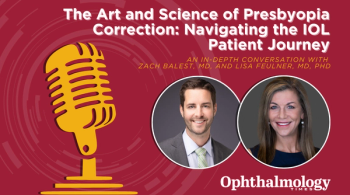
- Ophthalmology Times: July 15, 2020
- Volume 45
- Issue 12
Dropless, hands-free regimen key for patients
Following cataract surgery, the dropless option is proving to be a preferred method during recovery
This article was reviewed by Eric Donnenfeld, MD
Patients expressed a strong preference for a dropless medication regimen after cataract surgery compared with a conventional regimen of topical medications.
In addition to the convenience of not instilling eye drops multiple times a day for up to 4 weeks postoperatively, there was no significant difference in pain or inflammation when both regimens were compared.
Related:
In addition, the dropless regimen was less expensive, according to Eric Donnenfeld, MD, John A. Hovanesian, MD, and Chad Hummel, MD.
The dropless regimen comprises dexamethasone ophthalmic insert 0.4 mg (Dextenza, Ocular Therapeutix), ketorolac and phenylephrine (Omidria, Omeros Corp), and intracameral moxifloxacin 500 mcg. In terms of delivery, the only component delivered via punctal plug is dexamethasone ophthalmic insert and the only components delivered at the end of surgery are the dexamethasone ophthalmic insert and moxifloxacin. Ketorolac/phenylephrine is delivered intraoperatively but provides/contributes to both intraoperative and postoperative benefits such as a reduction in intraoperative complications and postoperative complications such as CME, and a decrease in postoperative pain and inflammation.
The conventional regimen included the standard topical regimen of prednisolone acetate 1% administered 4 times daily for 2 weeks and then twice daily for 2 weeks, moxifloxacin 0.5% administered 4 times daily for 10 days, and ketorolac administered 4 times daily for 4 weeks.
Related:
The study
The investigators conducted a randomized, self-controlled, prospective clinical study to compare the standard (control) and dropless (experimental) regimens for safety and ocular efficacy for controlling postoperative ocular pain, inflammation, and infection associated with cataract surgery.
A total of 56 patients (25 men, 31 women) were included in the study. Each patient underwent sequential bilateral cataract surgery 2 weeks apart and was randomly treated with the dropless regimen in 1 eye and the standard topical regimen in the fellow eye.
Donnenfeld reported that no significant differences were seen at any postoperative time points in the 2 groups in cell and flare, postoperative pain, best-corrected visual acuity, or macular thickness at 2 weeks, 1 month, and 2 months after cataract surgery.
No cases of endophthalmitis or cystoid macular edema developed in either group.
Related:
Two patients in the dropless group required rescue topical prednisolone acetate 1% for inflammation, and 1 patient in the standard drop group had rebound iritis requiring additional prednisolone acetate 1%.
Six patients in the topical medication study developed significant superficial punctate keratitis (SPK). No endophthalmitis or cystoid macular edema developed in the topical group.
When patients were questioned about which eye regimen they preferred, 96% (P < .0001) of patients chose the eye randomized to the dropless regimen; 2 of 56 patients preferred the standard topical regimen.
The investigators reached the following conclusions.
Compared with a traditional eyedrop regimen, patients receiving dexamethasone ophthalmic insert/ketorolac and phenylephrine + intracameral moxifloxacin expressed a strong preference for the dropless regimen.
No significant differences were seen in pain and the summed ocular inflammation score. No endophthalmitis developed in either group.
Related:
The dropless regimen significantly reduced the out-of-pocket expenses for patients because it contains a preservative-free corticosteroid. Also, there was less SPK and no medication toxicity.
“Dropless intracameral and intracanalicular insert delivery medications following cataract surgery are safe, and preservative-free,” Donnenfeld concluded. “These options are an efficacious alternative to traditional topical medications, increasing compliance, improving the ocular surface, and benefiting social distancing,” Donnenfeld concluded.
---
Eric Donnenfeld, MD
e:[email protected]
Dr. Donnenfeld is founding partner at Ophthalmic Consultants of Long Island and Connecticut, a clinical professor of ophthalmology at New York University in New York, and a Trustee of Dartmouth Medical School in Hanover, New Hampshire. John A. Hovanesian, MD, is a clinical assistant professor at the University of California Los Angeles, Stein Eye Institute. Chad Hummel, MD, is in private practice in Massapequa, New York. All authors reported being consultants to Ocular Therapeutix, which funded the study.
Articles in this issue
over 5 years ago
Toric stability: A minor change with a major impact for patientsover 5 years ago
Diagnosing a 'down looker'over 5 years ago
Gene therapy offers hope for choroideremiaover 5 years ago
Machine-learning algorithms could help predict course of NPDRover 5 years ago
Thyroid eye disease: Not limited to visual impairmentover 5 years ago
Beating burnout with camaraderieNewsletter
Don’t miss out—get Ophthalmology Times updates on the latest clinical advancements and expert interviews, straight to your inbox.













































.png)


